Management Perspectives: Employee Benefits, Hourly vs. Salaried & FLSA
VerifiedAdded on 2023/04/22
|8
|1869
|267
Essay
AI Summary
This essay explores the benefits of hourly versus salaried employees, focusing on the Fair Labor Standards Act (FLSA) and the importance of valuing unique skills and competencies in the workplace. It discusses how salaried employees, though expected to complete duties regardless of specific deadlines, may not receive overtime pay, while hourly employees are compensated based on actual hours worked and are generally eligible for overtime. The essay highlights the significance of workplace flexibility for hourly employees, the challenges in talent acquisition and retention, and the need for employers to align employee preferences with organizational goals. It also touches upon the Saint Leo University Core Value of Respect and the equal pay provisions of the FLSA, emphasizing the importance of fostering dedicated and committed workforces through respectable work environments.

Running head: MANAGEMENT
MANAGEMENT
Name of the Student:
Name of the University:
Author note:
MANAGEMENT
Name of the Student:
Name of the University:
Author note:
Paraphrase This Document
Need a fresh take? Get an instant paraphrase of this document with our AI Paraphraser
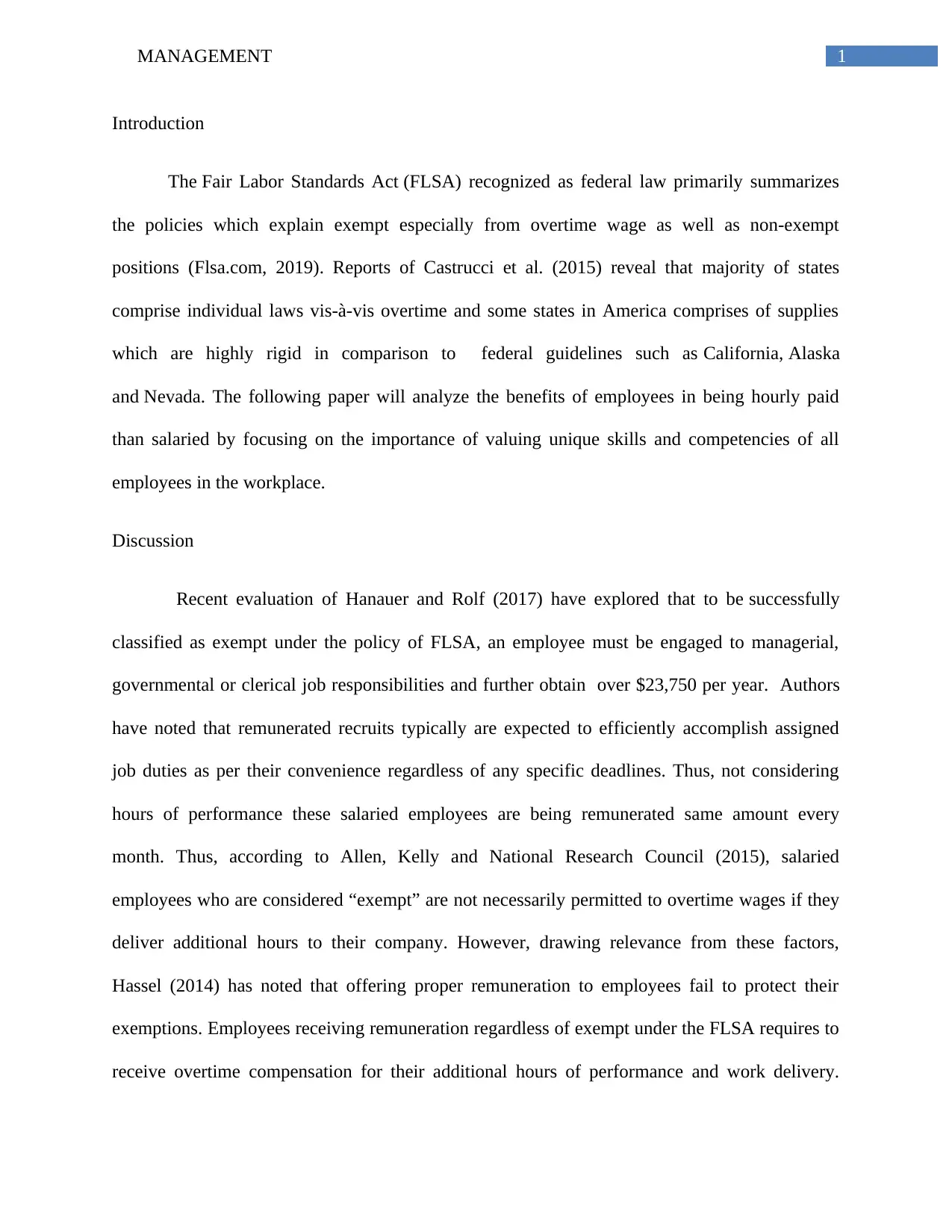
1MANAGEMENT
Introduction
The Fair Labor Standards Act (FLSA) recognized as federal law primarily summarizes
the policies which explain exempt especially from overtime wage as well as non-exempt
positions (Flsa.com, 2019). Reports of Castrucci et al. (2015) reveal that majority of states
comprise individual laws vis-à-vis overtime and some states in America comprises of supplies
which are highly rigid in comparison to federal guidelines such as California, Alaska
and Nevada. The following paper will analyze the benefits of employees in being hourly paid
than salaried by focusing on the importance of valuing unique skills and competencies of all
employees in the workplace.
Discussion
Recent evaluation of Hanauer and Rolf (2017) have explored that to be successfully
classified as exempt under the policy of FLSA, an employee must be engaged to managerial,
governmental or clerical job responsibilities and further obtain over $23,750 per year. Authors
have noted that remunerated recruits typically are expected to efficiently accomplish assigned
job duties as per their convenience regardless of any specific deadlines. Thus, not considering
hours of performance these salaried employees are being remunerated same amount every
month. Thus, according to Allen, Kelly and National Research Council (2015), salaried
employees who are considered “exempt” are not necessarily permitted to overtime wages if they
deliver additional hours to their company. However, drawing relevance from these factors,
Hassel (2014) has noted that offering proper remuneration to employees fail to protect their
exemptions. Employees receiving remuneration regardless of exempt under the FLSA requires to
receive overtime compensation for their additional hours of performance and work delivery.
Introduction
The Fair Labor Standards Act (FLSA) recognized as federal law primarily summarizes
the policies which explain exempt especially from overtime wage as well as non-exempt
positions (Flsa.com, 2019). Reports of Castrucci et al. (2015) reveal that majority of states
comprise individual laws vis-à-vis overtime and some states in America comprises of supplies
which are highly rigid in comparison to federal guidelines such as California, Alaska
and Nevada. The following paper will analyze the benefits of employees in being hourly paid
than salaried by focusing on the importance of valuing unique skills and competencies of all
employees in the workplace.
Discussion
Recent evaluation of Hanauer and Rolf (2017) have explored that to be successfully
classified as exempt under the policy of FLSA, an employee must be engaged to managerial,
governmental or clerical job responsibilities and further obtain over $23,750 per year. Authors
have noted that remunerated recruits typically are expected to efficiently accomplish assigned
job duties as per their convenience regardless of any specific deadlines. Thus, not considering
hours of performance these salaried employees are being remunerated same amount every
month. Thus, according to Allen, Kelly and National Research Council (2015), salaried
employees who are considered “exempt” are not necessarily permitted to overtime wages if they
deliver additional hours to their company. However, drawing relevance from these factors,
Hassel (2014) has noted that offering proper remuneration to employees fail to protect their
exemptions. Employees receiving remuneration regardless of exempt under the FLSA requires to
receive overtime compensation for their additional hours of performance and work delivery.
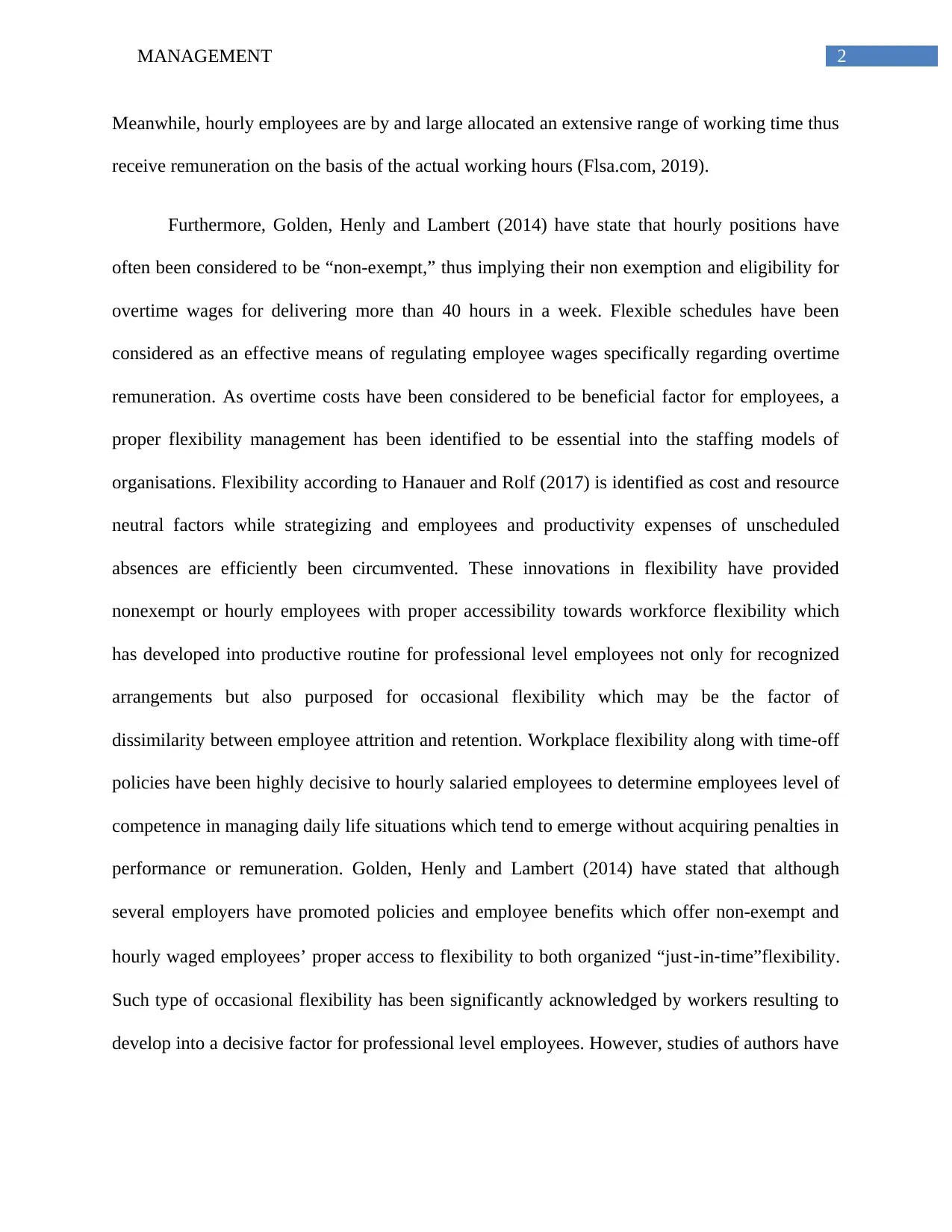
2MANAGEMENT
Meanwhile, hourly employees are by and large allocated an extensive range of working time thus
receive remuneration on the basis of the actual working hours (Flsa.com, 2019).
Furthermore, Golden, Henly and Lambert (2014) have state that hourly positions have
often been considered to be “non-exempt,” thus implying their non exemption and eligibility for
overtime wages for delivering more than 40 hours in a week. Flexible schedules have been
considered as an effective means of regulating employee wages specifically regarding overtime
remuneration. As overtime costs have been considered to be beneficial factor for employees, a
proper flexibility management has been identified to be essential into the staffing models of
organisations. Flexibility according to Hanauer and Rolf (2017) is identified as cost and resource
neutral factors while strategizing and employees and productivity expenses of unscheduled
absences are efficiently been circumvented. These innovations in flexibility have provided
nonexempt or hourly employees with proper accessibility towards workforce flexibility which
has developed into productive routine for professional level employees not only for recognized
arrangements but also purposed for occasional flexibility which may be the factor of
dissimilarity between employee attrition and retention. Workplace flexibility along with time-off
policies have been highly decisive to hourly salaried employees to determine employees level of
competence in managing daily life situations which tend to emerge without acquiring penalties in
performance or remuneration. Golden, Henly and Lambert (2014) have stated that although
several employers have promoted policies and employee benefits which offer non-exempt and
hourly waged employees’ proper access to flexibility to both organized “just‐in‐time”flexibility.
Such type of occasional flexibility has been significantly acknowledged by workers resulting to
develop into a decisive factor for professional level employees. However, studies of authors have
Meanwhile, hourly employees are by and large allocated an extensive range of working time thus
receive remuneration on the basis of the actual working hours (Flsa.com, 2019).
Furthermore, Golden, Henly and Lambert (2014) have state that hourly positions have
often been considered to be “non-exempt,” thus implying their non exemption and eligibility for
overtime wages for delivering more than 40 hours in a week. Flexible schedules have been
considered as an effective means of regulating employee wages specifically regarding overtime
remuneration. As overtime costs have been considered to be beneficial factor for employees, a
proper flexibility management has been identified to be essential into the staffing models of
organisations. Flexibility according to Hanauer and Rolf (2017) is identified as cost and resource
neutral factors while strategizing and employees and productivity expenses of unscheduled
absences are efficiently been circumvented. These innovations in flexibility have provided
nonexempt or hourly employees with proper accessibility towards workforce flexibility which
has developed into productive routine for professional level employees not only for recognized
arrangements but also purposed for occasional flexibility which may be the factor of
dissimilarity between employee attrition and retention. Workplace flexibility along with time-off
policies have been highly decisive to hourly salaried employees to determine employees level of
competence in managing daily life situations which tend to emerge without acquiring penalties in
performance or remuneration. Golden, Henly and Lambert (2014) have stated that although
several employers have promoted policies and employee benefits which offer non-exempt and
hourly waged employees’ proper access to flexibility to both organized “just‐in‐time”flexibility.
Such type of occasional flexibility has been significantly acknowledged by workers resulting to
develop into a decisive factor for professional level employees. However, studies of authors have
⊘ This is a preview!⊘
Do you want full access?
Subscribe today to unlock all pages.

Trusted by 1+ million students worldwide
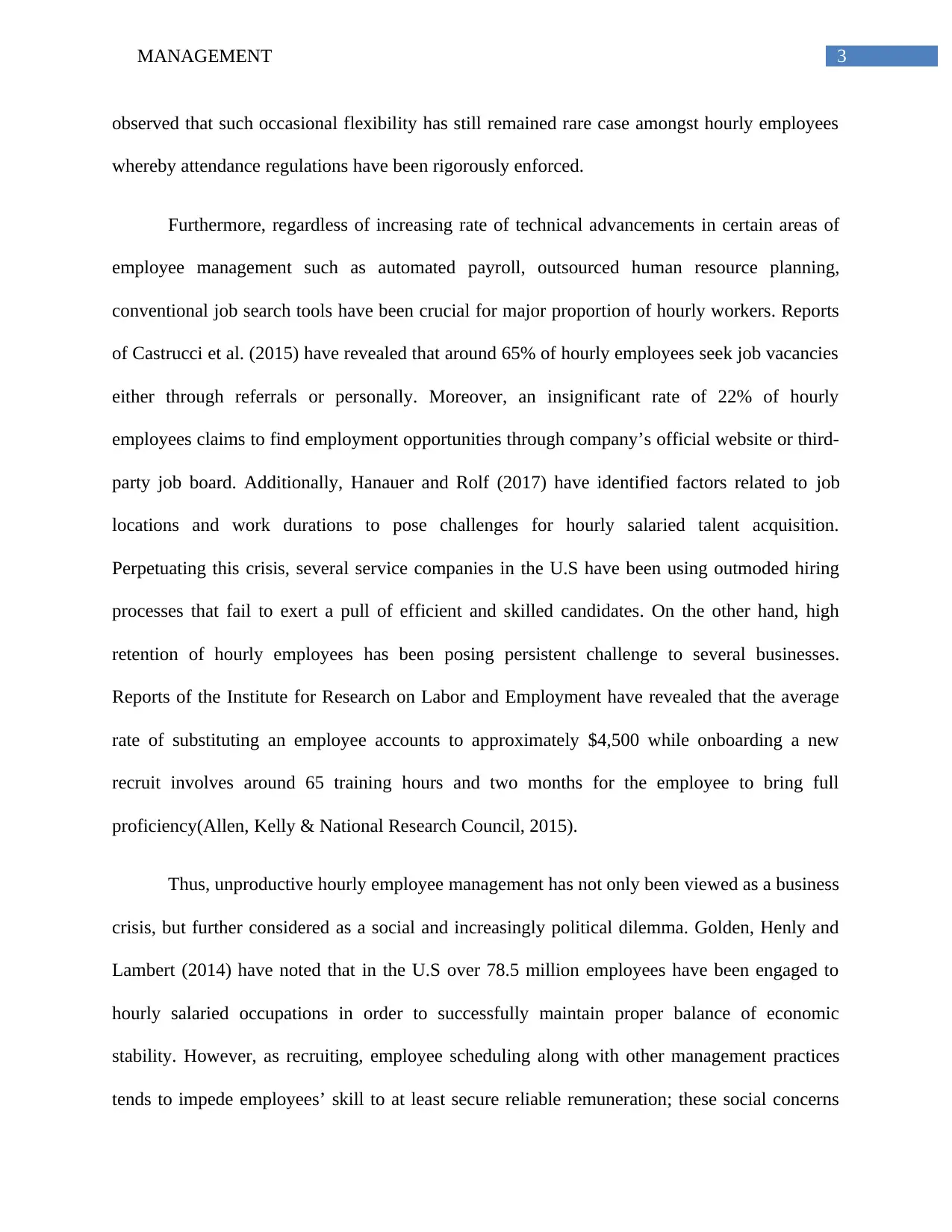
3MANAGEMENT
observed that such occasional flexibility has still remained rare case amongst hourly employees
whereby attendance regulations have been rigorously enforced.
Furthermore, regardless of increasing rate of technical advancements in certain areas of
employee management such as automated payroll, outsourced human resource planning,
conventional job search tools have been crucial for major proportion of hourly workers. Reports
of Castrucci et al. (2015) have revealed that around 65% of hourly employees seek job vacancies
either through referrals or personally. Moreover, an insignificant rate of 22% of hourly
employees claims to find employment opportunities through company’s official website or third-
party job board. Additionally, Hanauer and Rolf (2017) have identified factors related to job
locations and work durations to pose challenges for hourly salaried talent acquisition.
Perpetuating this crisis, several service companies in the U.S have been using outmoded hiring
processes that fail to exert a pull of efficient and skilled candidates. On the other hand, high
retention of hourly employees has been posing persistent challenge to several businesses.
Reports of the Institute for Research on Labor and Employment have revealed that the average
rate of substituting an employee accounts to approximately $4,500 while onboarding a new
recruit involves around 65 training hours and two months for the employee to bring full
proficiency(Allen, Kelly & National Research Council, 2015).
Thus, unproductive hourly employee management has not only been viewed as a business
crisis, but further considered as a social and increasingly political dilemma. Golden, Henly and
Lambert (2014) have noted that in the U.S over 78.5 million employees have been engaged to
hourly salaried occupations in order to successfully maintain proper balance of economic
stability. However, as recruiting, employee scheduling along with other management practices
tends to impede employees’ skill to at least secure reliable remuneration; these social concerns
observed that such occasional flexibility has still remained rare case amongst hourly employees
whereby attendance regulations have been rigorously enforced.
Furthermore, regardless of increasing rate of technical advancements in certain areas of
employee management such as automated payroll, outsourced human resource planning,
conventional job search tools have been crucial for major proportion of hourly workers. Reports
of Castrucci et al. (2015) have revealed that around 65% of hourly employees seek job vacancies
either through referrals or personally. Moreover, an insignificant rate of 22% of hourly
employees claims to find employment opportunities through company’s official website or third-
party job board. Additionally, Hanauer and Rolf (2017) have identified factors related to job
locations and work durations to pose challenges for hourly salaried talent acquisition.
Perpetuating this crisis, several service companies in the U.S have been using outmoded hiring
processes that fail to exert a pull of efficient and skilled candidates. On the other hand, high
retention of hourly employees has been posing persistent challenge to several businesses.
Reports of the Institute for Research on Labor and Employment have revealed that the average
rate of substituting an employee accounts to approximately $4,500 while onboarding a new
recruit involves around 65 training hours and two months for the employee to bring full
proficiency(Allen, Kelly & National Research Council, 2015).
Thus, unproductive hourly employee management has not only been viewed as a business
crisis, but further considered as a social and increasingly political dilemma. Golden, Henly and
Lambert (2014) have noted that in the U.S over 78.5 million employees have been engaged to
hourly salaried occupations in order to successfully maintain proper balance of economic
stability. However, as recruiting, employee scheduling along with other management practices
tends to impede employees’ skill to at least secure reliable remuneration; these social concerns
Paraphrase This Document
Need a fresh take? Get an instant paraphrase of this document with our AI Paraphraser
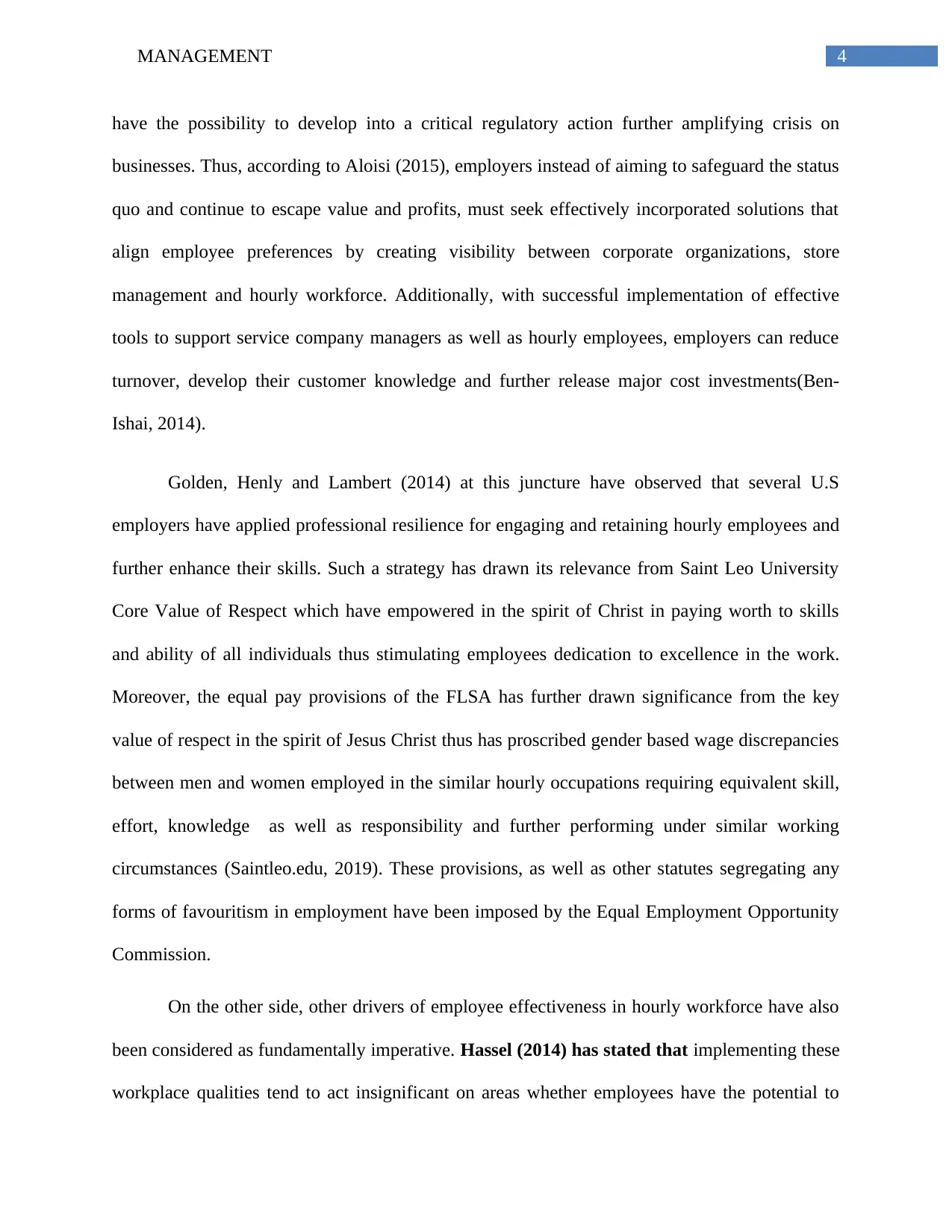
4MANAGEMENT
have the possibility to develop into a critical regulatory action further amplifying crisis on
businesses. Thus, according to Aloisi (2015), employers instead of aiming to safeguard the status
quo and continue to escape value and profits, must seek effectively incorporated solutions that
align employee preferences by creating visibility between corporate organizations, store
management and hourly workforce. Additionally, with successful implementation of effective
tools to support service company managers as well as hourly employees, employers can reduce
turnover, develop their customer knowledge and further release major cost investments(Ben-
Ishai, 2014).
Golden, Henly and Lambert (2014) at this juncture have observed that several U.S
employers have applied professional resilience for engaging and retaining hourly employees and
further enhance their skills. Such a strategy has drawn its relevance from Saint Leo University
Core Value of Respect which have empowered in the spirit of Christ in paying worth to skills
and ability of all individuals thus stimulating employees dedication to excellence in the work.
Moreover, the equal pay provisions of the FLSA has further drawn significance from the key
value of respect in the spirit of Jesus Christ thus has proscribed gender based wage discrepancies
between men and women employed in the similar hourly occupations requiring equivalent skill,
effort, knowledge as well as responsibility and further performing under similar working
circumstances (Saintleo.edu, 2019). These provisions, as well as other statutes segregating any
forms of favouritism in employment have been imposed by the Equal Employment Opportunity
Commission.
On the other side, other drivers of employee effectiveness in hourly workforce have also
been considered as fundamentally imperative. Hassel (2014) has stated that implementing these
workplace qualities tend to act insignificant on areas whether employees have the potential to
have the possibility to develop into a critical regulatory action further amplifying crisis on
businesses. Thus, according to Aloisi (2015), employers instead of aiming to safeguard the status
quo and continue to escape value and profits, must seek effectively incorporated solutions that
align employee preferences by creating visibility between corporate organizations, store
management and hourly workforce. Additionally, with successful implementation of effective
tools to support service company managers as well as hourly employees, employers can reduce
turnover, develop their customer knowledge and further release major cost investments(Ben-
Ishai, 2014).
Golden, Henly and Lambert (2014) at this juncture have observed that several U.S
employers have applied professional resilience for engaging and retaining hourly employees and
further enhance their skills. Such a strategy has drawn its relevance from Saint Leo University
Core Value of Respect which have empowered in the spirit of Christ in paying worth to skills
and ability of all individuals thus stimulating employees dedication to excellence in the work.
Moreover, the equal pay provisions of the FLSA has further drawn significance from the key
value of respect in the spirit of Jesus Christ thus has proscribed gender based wage discrepancies
between men and women employed in the similar hourly occupations requiring equivalent skill,
effort, knowledge as well as responsibility and further performing under similar working
circumstances (Saintleo.edu, 2019). These provisions, as well as other statutes segregating any
forms of favouritism in employment have been imposed by the Equal Employment Opportunity
Commission.
On the other side, other drivers of employee effectiveness in hourly workforce have also
been considered as fundamentally imperative. Hassel (2014) has stated that implementing these
workplace qualities tend to act insignificant on areas whether employees have the potential to
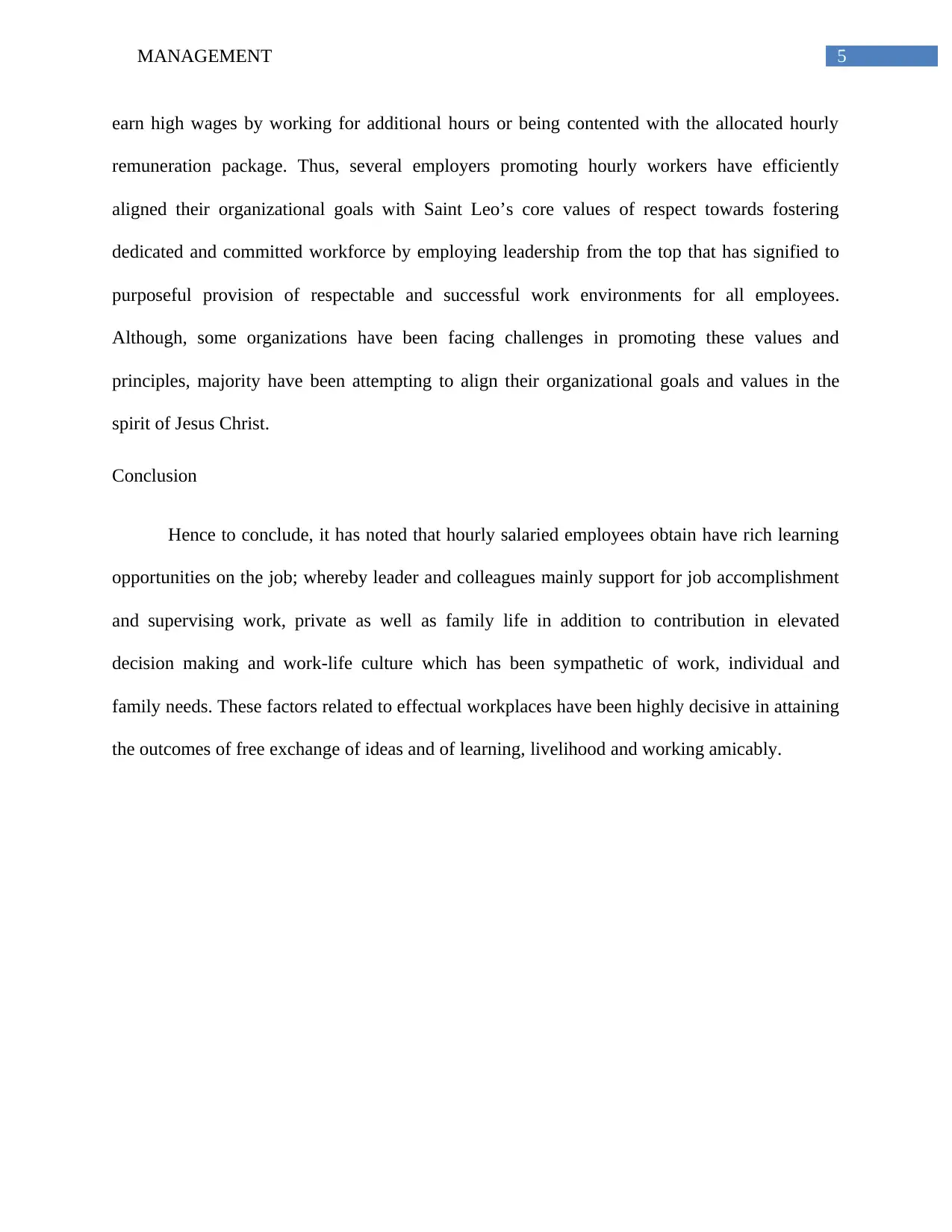
5MANAGEMENT
earn high wages by working for additional hours or being contented with the allocated hourly
remuneration package. Thus, several employers promoting hourly workers have efficiently
aligned their organizational goals with Saint Leo’s core values of respect towards fostering
dedicated and committed workforce by employing leadership from the top that has signified to
purposeful provision of respectable and successful work environments for all employees.
Although, some organizations have been facing challenges in promoting these values and
principles, majority have been attempting to align their organizational goals and values in the
spirit of Jesus Christ.
Conclusion
Hence to conclude, it has noted that hourly salaried employees obtain have rich learning
opportunities on the job; whereby leader and colleagues mainly support for job accomplishment
and supervising work, private as well as family life in addition to contribution in elevated
decision making and work-life culture which has been sympathetic of work, individual and
family needs. These factors related to effectual workplaces have been highly decisive in attaining
the outcomes of free exchange of ideas and of learning, livelihood and working amicably.
earn high wages by working for additional hours or being contented with the allocated hourly
remuneration package. Thus, several employers promoting hourly workers have efficiently
aligned their organizational goals with Saint Leo’s core values of respect towards fostering
dedicated and committed workforce by employing leadership from the top that has signified to
purposeful provision of respectable and successful work environments for all employees.
Although, some organizations have been facing challenges in promoting these values and
principles, majority have been attempting to align their organizational goals and values in the
spirit of Jesus Christ.
Conclusion
Hence to conclude, it has noted that hourly salaried employees obtain have rich learning
opportunities on the job; whereby leader and colleagues mainly support for job accomplishment
and supervising work, private as well as family life in addition to contribution in elevated
decision making and work-life culture which has been sympathetic of work, individual and
family needs. These factors related to effectual workplaces have been highly decisive in attaining
the outcomes of free exchange of ideas and of learning, livelihood and working amicably.
⊘ This is a preview!⊘
Do you want full access?
Subscribe today to unlock all pages.

Trusted by 1+ million students worldwide
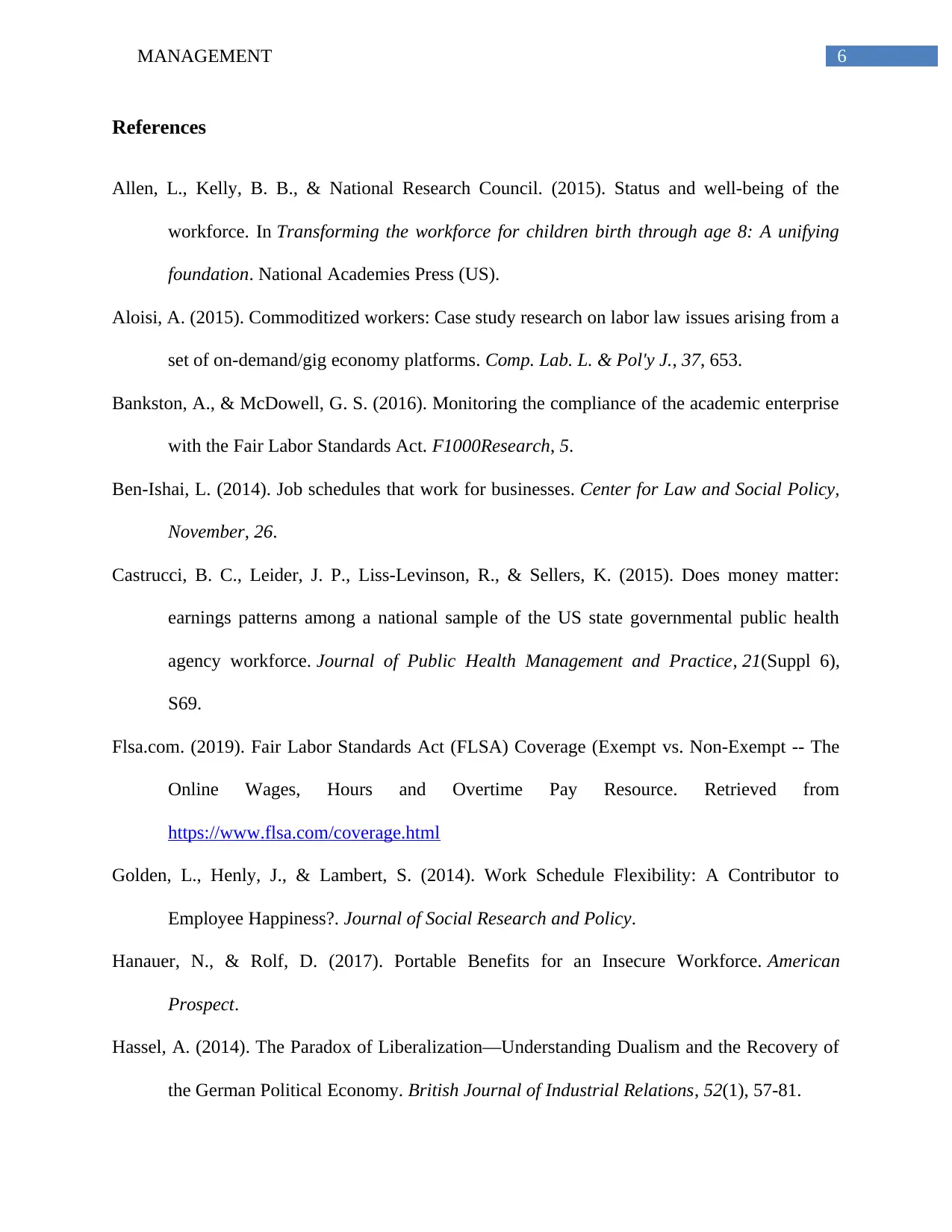
6MANAGEMENT
References
Allen, L., Kelly, B. B., & National Research Council. (2015). Status and well-being of the
workforce. In Transforming the workforce for children birth through age 8: A unifying
foundation. National Academies Press (US).
Aloisi, A. (2015). Commoditized workers: Case study research on labor law issues arising from a
set of on-demand/gig economy platforms. Comp. Lab. L. & Pol'y J., 37, 653.
Bankston, A., & McDowell, G. S. (2016). Monitoring the compliance of the academic enterprise
with the Fair Labor Standards Act. F1000Research, 5.
Ben-Ishai, L. (2014). Job schedules that work for businesses. Center for Law and Social Policy,
November, 26.
Castrucci, B. C., Leider, J. P., Liss-Levinson, R., & Sellers, K. (2015). Does money matter:
earnings patterns among a national sample of the US state governmental public health
agency workforce. Journal of Public Health Management and Practice, 21(Suppl 6),
S69.
Flsa.com. (2019). Fair Labor Standards Act (FLSA) Coverage (Exempt vs. Non-Exempt -- The
Online Wages, Hours and Overtime Pay Resource. Retrieved from
https://www.flsa.com/coverage.html
Golden, L., Henly, J., & Lambert, S. (2014). Work Schedule Flexibility: A Contributor to
Employee Happiness?. Journal of Social Research and Policy.
Hanauer, N., & Rolf, D. (2017). Portable Benefits for an Insecure Workforce. American
Prospect.
Hassel, A. (2014). The Paradox of Liberalization—Understanding Dualism and the Recovery of
the German Political Economy. British Journal of Industrial Relations, 52(1), 57-81.
References
Allen, L., Kelly, B. B., & National Research Council. (2015). Status and well-being of the
workforce. In Transforming the workforce for children birth through age 8: A unifying
foundation. National Academies Press (US).
Aloisi, A. (2015). Commoditized workers: Case study research on labor law issues arising from a
set of on-demand/gig economy platforms. Comp. Lab. L. & Pol'y J., 37, 653.
Bankston, A., & McDowell, G. S. (2016). Monitoring the compliance of the academic enterprise
with the Fair Labor Standards Act. F1000Research, 5.
Ben-Ishai, L. (2014). Job schedules that work for businesses. Center for Law and Social Policy,
November, 26.
Castrucci, B. C., Leider, J. P., Liss-Levinson, R., & Sellers, K. (2015). Does money matter:
earnings patterns among a national sample of the US state governmental public health
agency workforce. Journal of Public Health Management and Practice, 21(Suppl 6),
S69.
Flsa.com. (2019). Fair Labor Standards Act (FLSA) Coverage (Exempt vs. Non-Exempt -- The
Online Wages, Hours and Overtime Pay Resource. Retrieved from
https://www.flsa.com/coverage.html
Golden, L., Henly, J., & Lambert, S. (2014). Work Schedule Flexibility: A Contributor to
Employee Happiness?. Journal of Social Research and Policy.
Hanauer, N., & Rolf, D. (2017). Portable Benefits for an Insecure Workforce. American
Prospect.
Hassel, A. (2014). The Paradox of Liberalization—Understanding Dualism and the Recovery of
the German Political Economy. British Journal of Industrial Relations, 52(1), 57-81.
Paraphrase This Document
Need a fresh take? Get an instant paraphrase of this document with our AI Paraphraser

7MANAGEMENT
Saintleo.edu. (2019). Core Values | Saint Leo Undergraduate Admissions. Retrieved from
http://choose.saintleo.edu/about-saintleo/core-values/
U.S. Department of Labor. (2019). Compliance Assistance - Wages and the Fair Labor Standards
Act (FLSA) - Wage and Hour Division (WHD) - U.S. Department of Labor. Retrieved
from https://www.dol.gov/whd/flsa/
Saintleo.edu. (2019). Core Values | Saint Leo Undergraduate Admissions. Retrieved from
http://choose.saintleo.edu/about-saintleo/core-values/
U.S. Department of Labor. (2019). Compliance Assistance - Wages and the Fair Labor Standards
Act (FLSA) - Wage and Hour Division (WHD) - U.S. Department of Labor. Retrieved
from https://www.dol.gov/whd/flsa/
1 out of 8
Your All-in-One AI-Powered Toolkit for Academic Success.
+13062052269
info@desklib.com
Available 24*7 on WhatsApp / Email
![[object Object]](/_next/static/media/star-bottom.7253800d.svg)
Unlock your academic potential
Copyright © 2020–2025 A2Z Services. All Rights Reserved. Developed and managed by ZUCOL.

